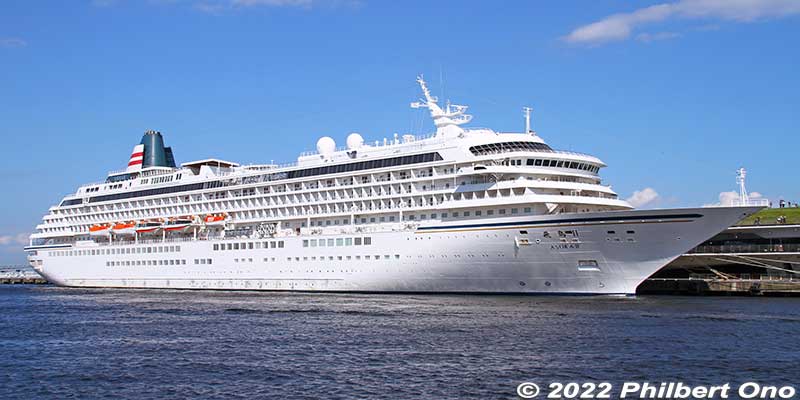
by Philbert Ono, Updated: Sep. 25, 2023
Japan’s largest luxury cruise ship.
Asuka II (飛鳥Ⅱ Asuka 2) is the only cruise ship owned and operated by NYK Cruises Co., Ltd. based in Yokohama and a wholly owned subsidiary of NYK Line (Nippon Yusen Kaisha 日本郵船株式会社), Japan’s largest maritime transport company and member of the huge Mitsubishi Group. NYK Line operates over 600 ships of all kinds including container ships, car carrier ships, tankers, LNG carriers, and ferries sailing to/from 350+ ports around the world.
Asuka II’s main selling point is its large size and international fame. Originally designed for the U.S. market as Crystal Harmony, interior spaces are more spacious like the entrance hall and stairway which you first see when boarding. The ship’s beautiful artwork adds to the elegance. The ship has more places to lounge around than the other two smaller Japanese cruise ships.
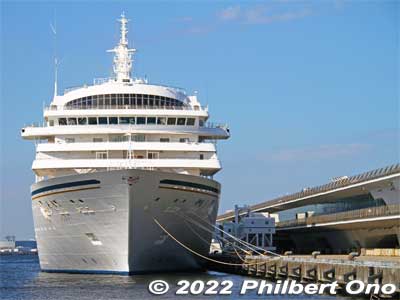
Above the bridge overlooking the bow is the stunning Vista Lounge with huge vertical windows presenting the ocean and scenery ahead. Evening entertainment includes big production shows.
Also unique are the large communal baths, now actually outdoors overlooking the ocean (rotenburo). They were installed during major refurbishing in 2020. The outdoor baths are closed when the ship is near land, however. Don’t want any onshore voyeurs gawking at bathers. Another selling point is that all passenger cabins have a bathtub and Simmons mattresses. (Japan’s hotel industry seems to love this bedding brand.)
Wi-Fi is available in all cabins and public spaces (except on the top-most deck 12). All guests can use Wi-Fi once a day for free up to 30 minutes. Guests in higher class cabins have longer free access. Or you can pay ¥3,000/day for unlimited access. Photos of passenger cabins here.
The ship is too big to dock at smaller (shallower) ports. So if you want to visit a place like Yakushima island, go on Pacific Venus or Nippon Maru instead. And for elderly and wheelchair passengers, the ship might require more effort to get around compared to the two smaller ships.

The ship was named after Japan’s Asuka Period (飛鳥時代) from 593 to 710, the dawn of Japanese culture, art, Buddhism, and Confucianism. The Asuka Period was when Prince Shotoku Taishi (574–622) was active introducing Buddhism to Japan. He also founded the famous Horyuji Temple in Nara, known for the world’s oldest wooden building.
The Asuka Period is named after the old Imperial capital in Asuka (明日香村), Nara Prefecture (old Yamato Province). Asuka today is a National Historic Site noted for numerous kofun burial mounds for the ancient nobility. Asuka is might too far away from the nearest port in Osaka for any shore excursion.
The ship’s name was selected from suggestions by the public. It supposed to mean that a new oceangoing culture was to develop through interaction between people and between people and nature.
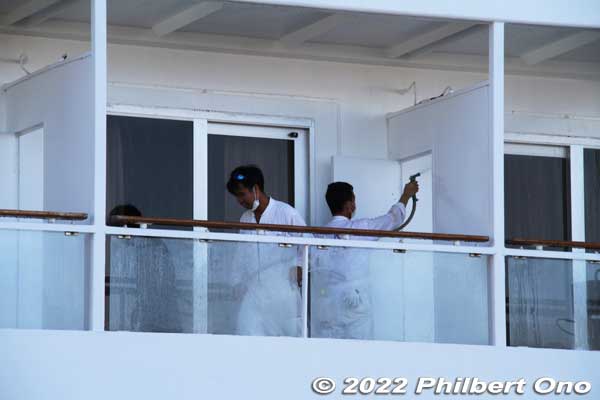
Asuka II: Pros
・Biggest Japanese cruise ship originally designed for the U.S. cruise market (Crystal Cruises). Larger capacity, more space, and more facilities.
・Most famous Japanese cruise ship, reputable history and lots of charisma.
・Many cabins (60%) have a balcony.
・All cabins have a bathtub.
・Communal bath is outdoors.
・Backed by Japan’s largest maritime transport company.
・Homeported in Yokohama, Japan’s busiest cruise departure port.
Cons
・Cannot dock at smaller ports.
・More crew/passengers increase chances of COVID-19 coming aboard (as of 2022).
・Ship is over 30 years old. (Newbuild ship coming in 2025.)
・Not international (passengers almost exclusively Japanese).
・Website not in English.
New cruise ship (Asuka III) [UPDATED]
Asuka II is already over 30 years old. It was launched before the advent of the Internet, before the spread of cell phones and Wi-Fi, before the appearance of mega-ships, and before CO2 emissions became an even more serious problem.
So it’s exciting to hear that NYK Cruises signed a contract in spring 2021 with Meyer Werft shipyard in Papenburg, Germany to build a new cruise ship. NYK originally wanted a Japanese shipbuilder, but there were none with the experience and expertise to build the desired ship.
The new ship, whose name was announced in Sept. 2023 as Asuka III, is due to be home-ported in Yokohama and start operations in summer 2025. NYK also announced that they will operate both the Asuka II, and Asuka III. The new ship will not replace the Asuka II. The new ship will be slightly larger than the Asuka II in gross tonnage, but have fewer cabins and lower capacity (744 passengers and 470 crew). This means there will be more room for everyone. It will still be Japan’s largest cruise ship.
All 385 passenger cabins will have a balcony. (Sounds expensive.) The ship will also have single-bed cabins to make it cheaper for solo travelers. (Great!) Other features include Wi-Fi in all cabins, 100% outside-air ventilation, and touchless buttons in elevators, etc. It will have a shallower draft than Asuka II so it can dock at smaller ports.
Asuka III will also be more ecological and environment friendly as follows:
- Japan’s first cruise ship to be partially powered by LNG (liquefied natural gas) to reduce CO2 emissions.
- The Dynamic Positioning System (DPS) keeps the ship in a fixed position so it won’t need to drop anchor and damage the seabed.
- While in port, the ship can hookup to shoreside power instead of burning fuel to generate onboard power (less air pollution). Japan currently has no ports which can provide LNG fuel or shoreside power to ships. However, the ship’s homeport of Yokohama is making plans to provide LNG fuel and shoreside power as it aims for carbon neutrality.
Sounds like a super ship for Japan. Hope they give public tours. New ship’s website: https://asukaluxury.asukacruise.co.jp/
Official website: https://www.asukacruise.co.jp/
Facebook (English): https://www.facebook.com/ennykcruise/
| Asuka II (Asuka 2) 飛鳥Ⅱ | Asuka III 飛鳥ⅡI | |
|---|---|---|
| Built | 1989 by Mitsubishi Heavy Industries, Nagasaki, Japan | 2025 by Meyer Werft, Germany |
| Capacity* | 872 pax, 490 crew | 744 pax, 470 crew |
| Passenger cabins* | 436 (60% w/balcony) | 385 (all with balcony) |
| Wheelchair cabins | 4 twin-bed cabins | ? |
| Length / Width | 241 m / 29.6 m | 228.9 m / 29.8 m |
| Draught | 7.8 m | 6.7 m |
| Decks | 8 | ? |
| Gross tonnage | 50,444 | 51,950 |
| Home port | Yokohama | Yokohama |
| Operator | NYK Cruises (Asuka Cruise) | NYK Cruises (Asuka Cruise) |
| Parent company | NYK Line | NYK Line |
| Refurbished | 2020 | — |
| Remarks | Originally Crystal Harmony for Crystal Cruises in the U.S. In service as Asuka II from 2006. | Name announced in Sept. 2023. |
| Website | asukacruise.co.jp | asukaluxury.asukacruise.co.jp |
| Current location | Map | Germany |
NYK Line history
Founded in 1885, NYK has a long, illustrious, and sometimes sad (World War II) maritime history. Japan’s commercial shipping history largely reflects NYK’s history following the collapse of Japan’s samurai rule (Edo Period) in 1868.
NYK had close ties to the modern (Meiji) Japanese government and was the de facto national carrier for shipping. It successfully squeezed out American and British ship companies like Pacific Mail Steamship Co. and P&O which had monopolized shipping routes within and to/from Japan since the 1860s. Japan’s shipping industry was finally under Japanese control.
NYK’s forerunner company, Mitsubishi Shokai (三菱商会), started Japan’s first ocean liner service in 1875 with a route between Yokohama and Shanghai. British liner P&O eventually quit this route when it couldn’t compete with Mitsubishi Shokai’s cutthroat fares.
By the end of the 19th century, NYK had ocean liners sailing between the Far East and Seattle and London, breaking the monopoly of American and British companies serving transpacific routes.
Also, during the late 19th century, NYK provided passenger-cargo ships like the British-built Yamashiro Maru (the first Japanese emigration ship), Wakanoura Maru, Takasago Maru, and Miike Maru (Japan’s largest ship at the time) to transport many of the 29,000+ government-contracted Japanese labor emigrants (Kanyaku Imin) to Honolulu, Hawaii.
Meanwhile, NYK Line’s rival O.S.K. Line provided ships for Japanese emigrants going to South America. In this way, Japanese maritime companies avoided competing directly with each other and covered different areas and markets.
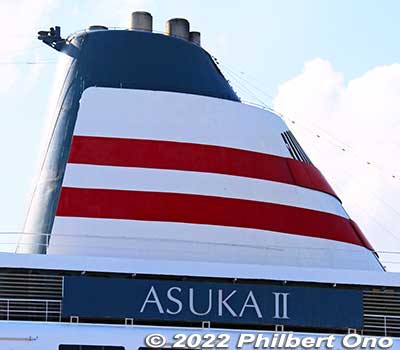
The corporate symbol of NYK Line Group companies is two red, horizontal stripes on a white background. The two stripes represent the two maritime transport companies (Mitsubishi Mail Steamship Company and Kyodo Unyu Kaisha) which merged in October 1885 to form the company. Since 1929, all NYK Line ships, including container ships and Asuka II, sport this logo on the funnel.
During World War II, the Imperial Japanese Army and Navy requisitioned most passenger and cargo ships from shipping companies and converted them into military transport and hospital ships. They became common military targets for U.S. submarines.
NYK lost 185 ships and many crew members in the war and only 37 vessels survived. Before World War II, Japan had the world’s third largest gross tonnage of commercial ships. The war decimated Japan’s ships to one-fourth of what it was.
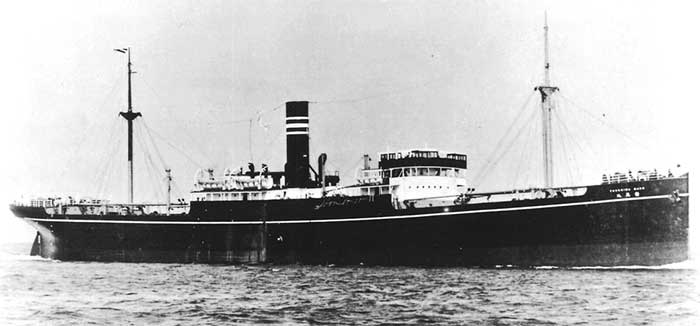
One sad and tragic World War II sinking was when NYK Line’s Tsushima Maru passenger-cargo ship was torpedoed and sunk by the USS Bowfin submarine (now displayed at Pearl Harbor, Hawaii) on August 22, 1944.
The ship was in a convoy sailing between Amami Oshima and Yakushima islands when it was sunk. It was evacuating over 1,600 civilians, including 834 school children, from Okinawa to Kagoshima Prefecture. Most of the passengers and children died.
The Bowfin likely thought it was a troop ship and apparently unaware it was carrying civilians. Afraid of being torpedoed as well, the other ships in the convoy just sped away without rescuing the survivors. The Tsushima-maru Memorial Museum in Naha, Okinawa is dedicated to this heartbreaking tragedy.
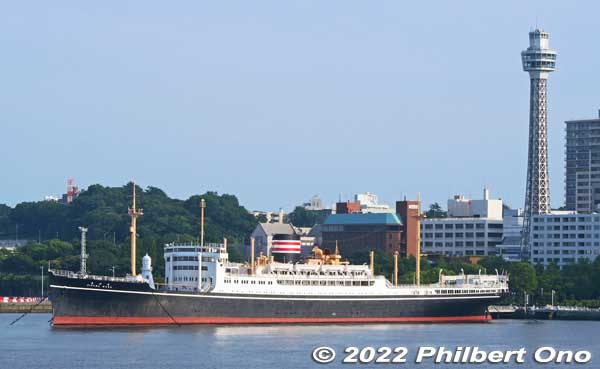
NYK’s sole ocean liner to survive the war was the Hikawa Maru. Before the war, it transported passengers and celebrities between Yokohama and Seattle/Vancouver. During the war, it was a hospital ship. After the war, it repatriated demobilized Japanese troops overseas back to Japan. Then from 1953 to 1960, it restarted ocean liner service between Yokohama and Seattle and became part of the Japanese maritime transport industry’s miraculous post-war recovery.
The 30-year-old Hikawa Maru was retired in August 1960, and it became a museum ship in 1961 next to Yamashita Park near Yokohama Port. It has been there ever since. The ship is owned by NYK Line and a National Important Cultural Property.
NYK also has the NYK Maritime Museum in Yokohama. [Update: NYK Maritime Museum is closed from April 1, 2023 to Oct. 2026 as it moves to another location.]
With the retirement of the Hikawa Maru, NYK Line withdrew from the passenger ship business. It wasn’t until 30 years later when NYK reentered the passenger ship business by establishing Crystal Cruises, Inc. in Los Angeles, California in 1988 to offer luxury cruises to the U.S. market. Crystal Cruises started out with the newly built Crystal Harmony cruise ship whose maiden voyage was from San Francisco to Alaska in late July 1990.
About NYK Cruises
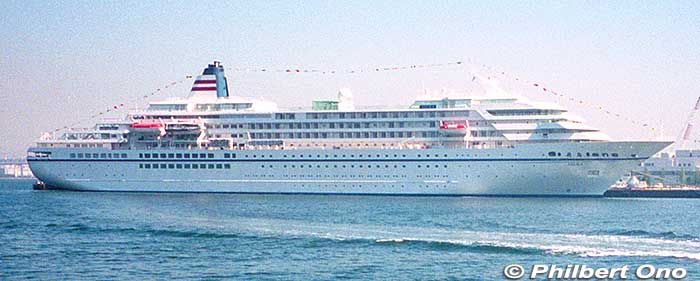
NYK Line also established NYK Cruises Co., Ltd. in 1990 to serve the Japanese cruise market. From October 1991, NYK Cruises started operating the first Asuka cruise ship owned by parent company NYK Line. In March 2000, it bought the Asuka from NYK Line.
In January 2006, NYK Cruises bought the 16-year-old Crystal Harmony from Crystal Cruises and renamed it Asuka II. The old Asuka was sold off, and Asuka II started operations in February 2006. Asuka II’s previous life as Crystal Harmony was reknown among cruise fans, making it Japan’s most famous cruise ship.
Award-winning Crystal Cruises still operated the Crystal Symphony and Crystal Serenity cruise ships. In May 2015, NYK Line sold Crystal Cruises and its ships to Genting Hong Kong which went bankrupt in Jan. 2022. Another company has since taken over Crystal Cruises.
Both NYK Cruises and parent company NYK Line have been seeing red ink in recent years. NYK Line suffered a loss of about ¥44.5 billion (US$400 million) for the fiscal year ending March 31, 2019.
In January 2019, NYK Line agreed to transfer 50 percent of NYK Cruises shares to Anchor Ship Partners Co., Ltd. for the joint operation of the cruise ship business.
Everyone is looking forward to seeing their new cruise ship in spring 2025. It will be over 30 years since the last time we saw a newbuild cruise ship in Japan. Hopefully, the company will get a good return on their investment.
Reference
Asuka Cruises (Japanese): https://www.asukacruise.co.jp/
Asuka Cruises (English): https://www.asukacruise.co.jp/english/
Asuka Cruises Facebook (English): https://www.facebook.com/ennykcruise/
Also see: Nippon Maru | Pacific Venus
Content Navigator
- Ship comparison
- Japanese cruise ship advantages
- COVID-19 protocols
- Basic cruise rules
- Safety Record
- FAQ
- Asuka II (Current page)
- Nippon Maru
- Pacific Venus
Ports for Cruise Ships in Japan
- Cruise ship departure ports
- Japan’s popular ports of call
- Shore excursions
- Mega-ships and harbor bridges
- Japanese port history
- Port town songs
- Major Japanese Ports: Yokohama | Tokyo | Kobe | Hakodate | Nagoya | Kanazawa | Toyama | Amami-Oshima Naze | Yakushima Miyanoura
State of Japanese Cruise Industry in mid-2022
- COVID-19 not over yet
- International cruise ships in Japan
- Japan still closed to international cruising
- Essential Japanese Vocabulary